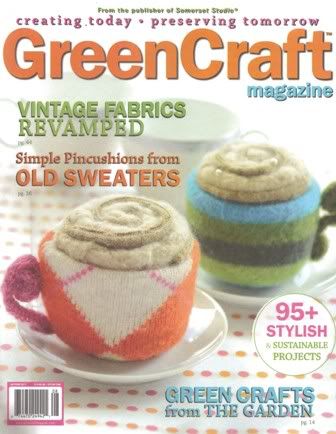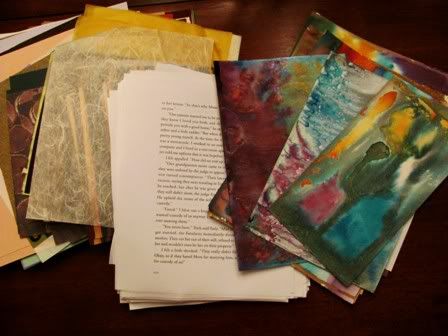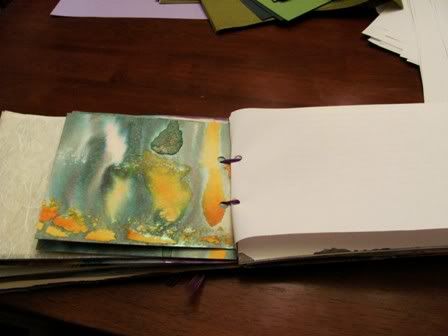 While I admit that I am addicted to art magazines, I never feel guilty buying an issue of Greencraft magazine. All the art projects in it are made from recycled materials -- things like old sweaters, cardboard, junk mail, even dryer sheets -- and the content is never boring or predictable.
While I admit that I am addicted to art magazines, I never feel guilty buying an issue of Greencraft magazine. All the art projects in it are made from recycled materials -- things like old sweaters, cardboard, junk mail, even dryer sheets -- and the content is never boring or predictable.In the Autumn 2011 issue there are a bunch of great ideas (including a way for me to finally recycle all these old beautiful calendars I can't bear to throw away) but the one idea I found most interesting was a notepad made from a hardcover book board, old end papers from other books, and a ribbon. It was so beautifully simple I immediately saw how I could adapt it into a green journal, using book boards for covers and filling it with pages made from the ton of stuff I have in my scrap paper bin.
I assembled the tools I needed, and started with some book boards that were left over from another project, and picked two that were the same size. Once I trimmed the ragged edges on the binding side, I punched two holes at the top of each board (I don't have a 2-hole punch, so I tucked the boards in the end of my 3-hole punch, punched one hole in them, and then flipped them over and punched another hole on the opposite side. Worked great.
 For the pages I raided my scrap paper bin, and used a chapter from an old manuscript, watercolor paintings that didn't work out, some odds and ends I'd trimmed from other projects, etc. I mixed them up and trimmed them slightly smaller than the book board covers, but I didn't worry about making them all equal in size because I think that makes the journal pages more interesting. I then stacked them so that all the white or unused sides were facing up, and them punched holes in them the same way I did the covers.
For the pages I raided my scrap paper bin, and used a chapter from an old manuscript, watercolor paintings that didn't work out, some odds and ends I'd trimmed from other projects, etc. I mixed them up and trimmed them slightly smaller than the book board covers, but I didn't worry about making them all equal in size because I think that makes the journal pages more interesting. I then stacked them so that all the white or unused sides were facing up, and them punched holes in them the same way I did the covers.Putting the journal together was simple; I put the pages inside the covers, threaded some narrow organdy ribbon through the holes and tied them all together with a bow. I left it loose so I could turn the pages, but the next time I made one I'll probably use binder rings or some elastic ribbon or cord to have more give in the binding.
By stacking all the white/unused sides in the same direction I gave myself space to write or paint something on the right side of the journal. I plan to put photos or pictures on the left/used sides. I'm not going to alter the book board covers, though, because I think they're charming just the way they are.
 If you don't have any book boards to recycle you can harvest them from any old used books available at flea markets, thrift stores or rummage sales. Some mixed media art suppliers sell them, too. If you're not into making journals, you can adapt this idea to make a green photo album or scrapbook. You don't have to use the same materials for the pages as I did, either; old maps, leftovers from scrapbooking projects, pages from magazines, pamphlets, greeting cards, photographs, envelopes, souvenirs, fabric or anything that appeals to you. This might also be a great project for kids to teach them how to recycle some of their old artwork, school papers, doodles and so on.
If you don't have any book boards to recycle you can harvest them from any old used books available at flea markets, thrift stores or rummage sales. Some mixed media art suppliers sell them, too. If you're not into making journals, you can adapt this idea to make a green photo album or scrapbook. You don't have to use the same materials for the pages as I did, either; old maps, leftovers from scrapbooking projects, pages from magazines, pamphlets, greeting cards, photographs, envelopes, souvenirs, fabric or anything that appeals to you. This might also be a great project for kids to teach them how to recycle some of their old artwork, school papers, doodles and so on.

The more I look at these "alternative art" projects of yours, the more the idea appeals to me. Not necessarily in this same way, but using other artistic interests. I'll have to think about it and scrape together an hour or two from somewhere...
ReplyDeleteI just succumbed to the lure of ordering and an art magazine from the UK called Wrap. They decided to make all their prints on paper that could be reused as wrapping paper (gift tags/notecards). While I don't wrap a ton of gifts, I do make origami and anything that makes good wrapping paper can be used for origami. It might make some really good journalling projects too if you like the illustration style http://www.thewrappaper.com/
ReplyDelete